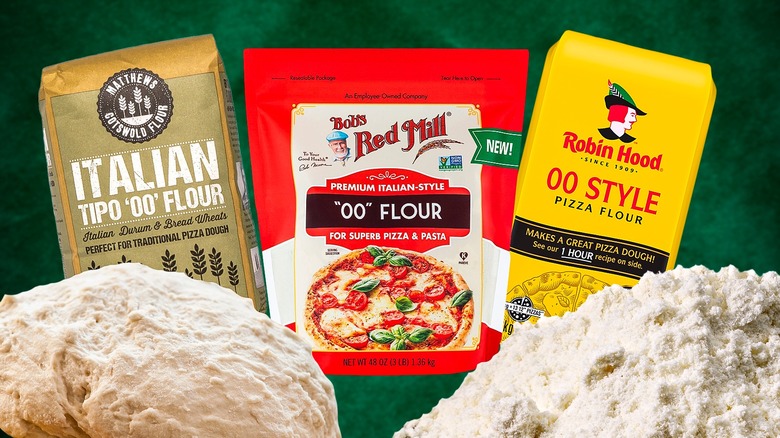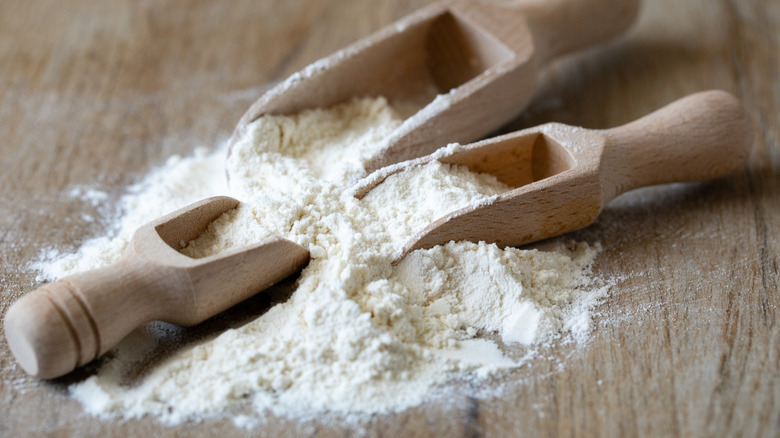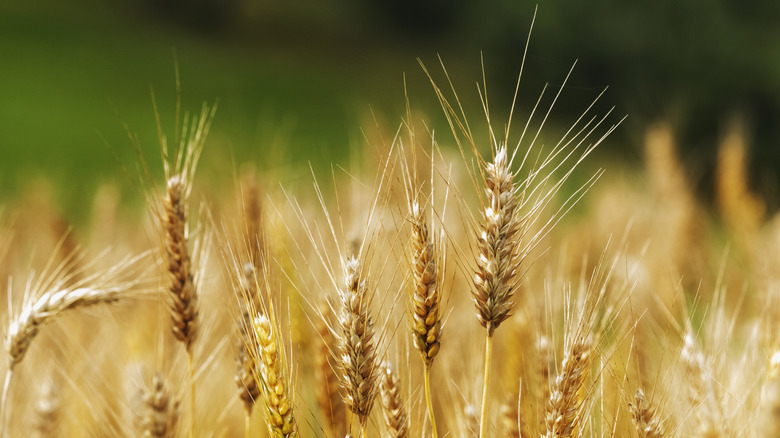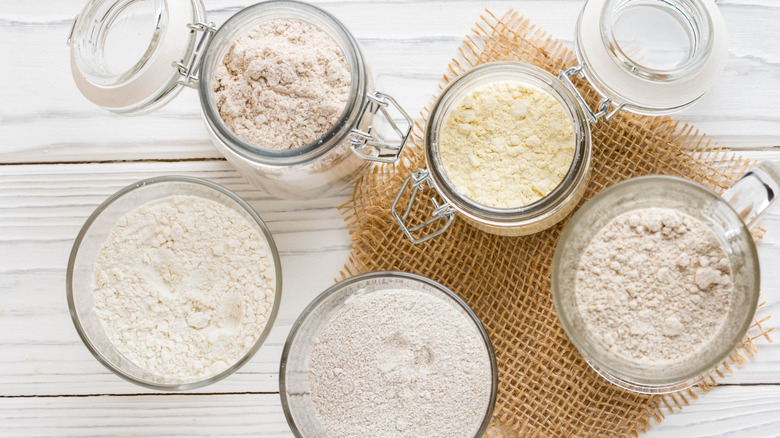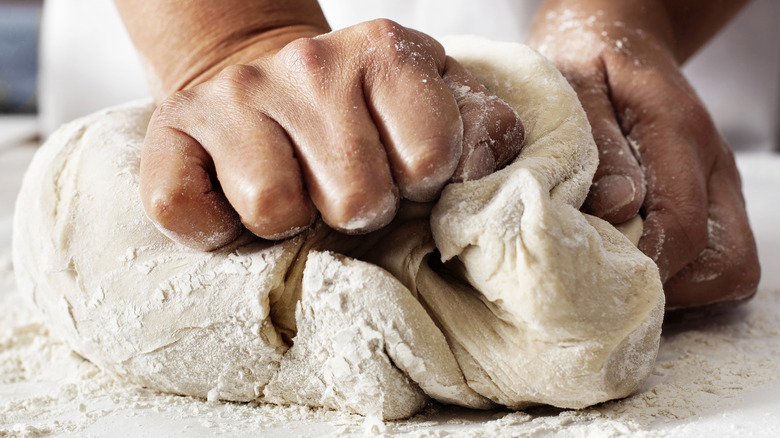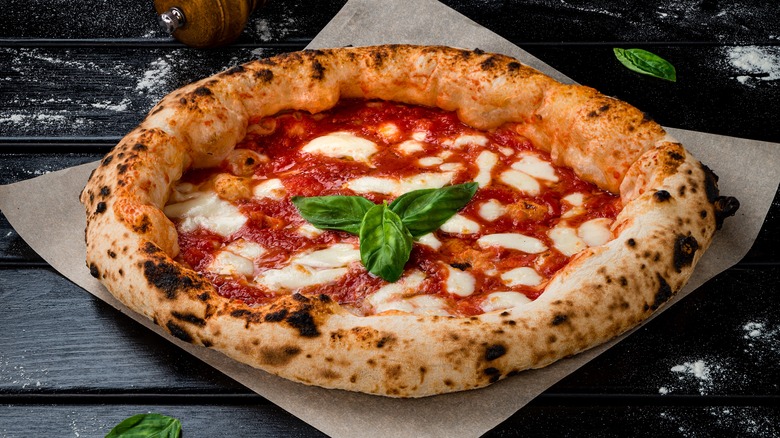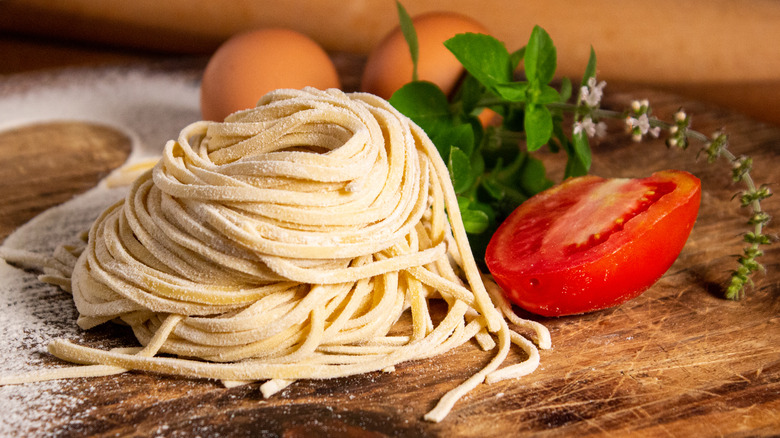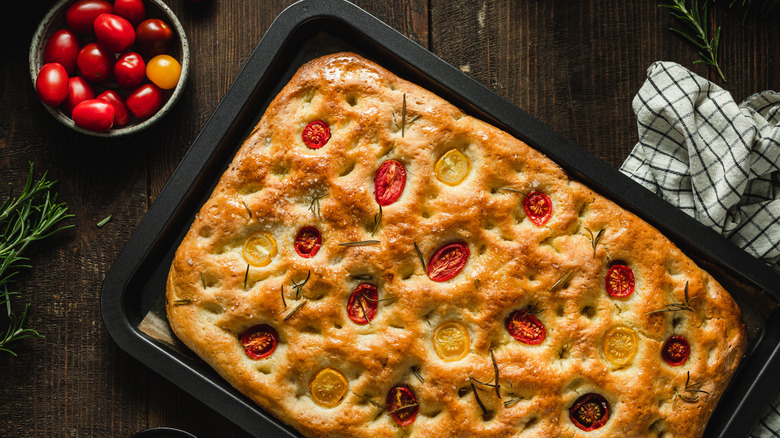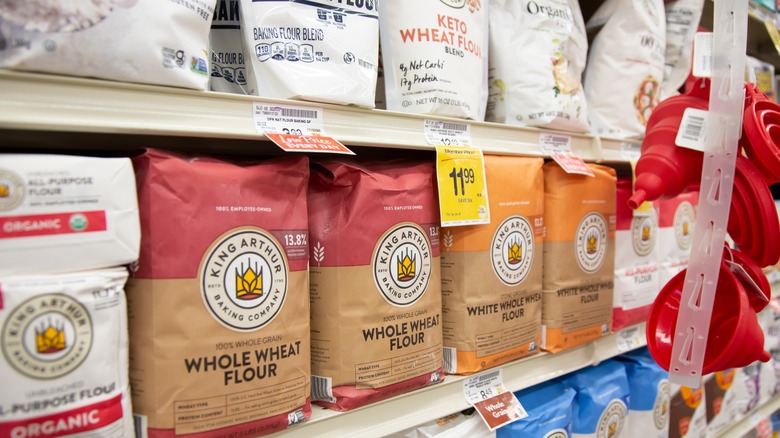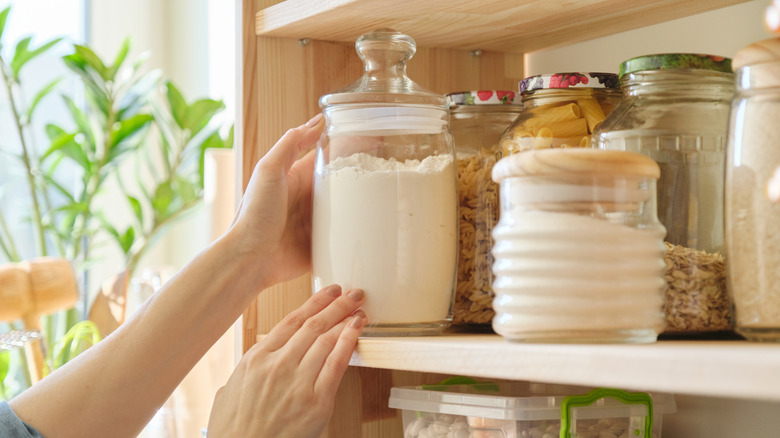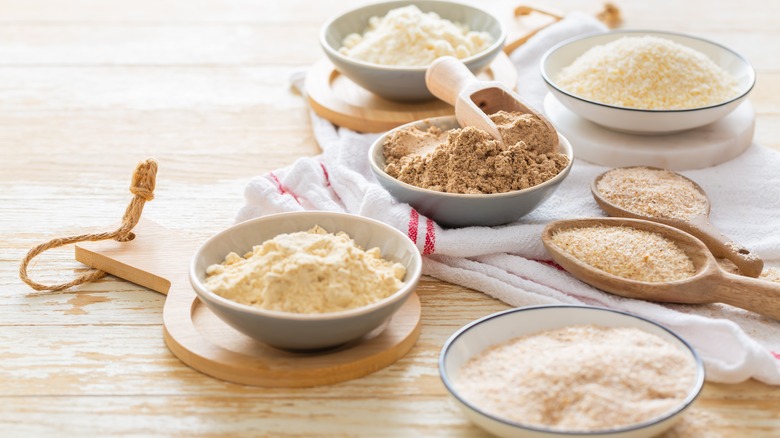What Is 00 Flour And Why Does Your Recipe Call For It
If you've made a recent trip to the baking aisle of your grocery store, you may have spotted a new flour on the shelves. The grain in question? 00 flour, an ingredient that has appeared mysteriously and stylishly on the baking scene much like agent 007 does at a villainous cocktail party. In all likelihood, 00 flour has begun to pop up thanks to home cooks hoping to recreate gourmet dishes at home. According to a Polaris Market Research report, the market for 00 flour is expected to double by 2032, from 2.08 billion to 4.24 billion USD.
The only thing holding back this product? Most people in the States don't know what it is or how to use it, even though it's been a staple in Italian baking for hundreds of years. Enter my little guide to 00 flour, a crash course on how and when to use this Italian ingredient for your baking purposes.
For the skeptical, here's a little info on me, your 00 flour expert for today. As the former managing editor of a baking magazine, I've had experience testing and tasting the difference between numerous flours. For a special Italian-themed issue, I worked on several recipes with 00 flour to better understand its unique properties and uses. I've made both pizza and pasta with this flour, and am familiar with several of the different brands that offer it. Without further ado, let me share some of my hard-won wisdom on this specialty Italian flour.
What is 00 flour
If you've spotted 00 flour (also called doppio 00) in the grocery store, you probably saw it associated with pizza. Indeed, some brands of flour, including King Arthur, will even have it labeled 00 Pizza Flour. This is because 00 flour is often used for pizza dough, pasta dough, and, occasionally, bread dough. In Italy, you can easily find 00 flour in the grocery aisles, as it's the building block of so many Italian staples. So what does the "00" part of the label mean?
In Europe, 00 is actually in reference to the size of the grind (very finely ground) of the flour, with the "2" label representing the largest grind setting for the flour. Conversely, in America, flour is often distinguished by protein level, with cake flour and pastry flour existing on the low end of the range, and bread flour on the high end. Though cake flour and pastry flour are as finely ground as 00 flour, they have very different protein levels, which can make classification for 00 flour so difficult.
00 flour has varying protein levels, from 7% all the way up to 14%, depending on the manufacturer or brand, but it most commonly has a protein level between 11% and 13%. That said, it generally skews higher than typical all-purpose flour and lower than bread flour. This combination of fine grind and higher protein makes 00 flour so ideal for the delicate yet chewy elements of pasta and pizza dough.
How is it made
00 flour is primarily made from soft durum wheat, a spring wheat that is more commonly known for making semolina flour, which in turn is used to make many pasta doughs. The wheat kernel — or the part that gets milled into flour — is comprised of the germ, bran, and endosperm. 00 flour is traditionally only made from the tender endosperm, with the bran and germ discarded early on in the milling process. For reference, whole wheat flour is made from the entire wheat kernel, so the nutrient-rich germ and bran are included. The endosperm is where all the rich starch and protein lie, making for a white and starchy flour.
The flour can be coarsely ground, as is the case with semolina, or it can be ground much finer into 00 flour. As soft durum wheat is much softer than other wheat, it takes much less grinding to make it silky, which means that the gluten strands receive less damage during the grinding process. This is a good thing because to achieve its powdery finish, the flour has to pass through the mill grinder multiple times. Conversely, all-purpose flour or bread flour are made of hard wheats or a mixture of hard and soft wheat, which means that to achieve the fineness 00 flour has, the gluten would be severely damaged in order to break it down.
00 flour vs other flour
As noted before, most flours are separated from 00 flour due to its fine grind and protein level. While cake and pastry flour are both as finely ground as 00 flour, they both have a much lower protein level (7% to 8%). Plus, some cake flour brands are bleached, meaning chemically treated to make a softer, whiter baked good. As a rule, 00 flour is an unbleached flour. Self-rising flour, which is often used to make such tender treats as biscuits and pancakes, has a lower protein level, and packs some add-ins like salt and baking powder in the mix, while 00 flour contains no additives.
Meanwhile, bread flour has a comparable protein level (about 12% to 14%), but it's still isn't as finely ground as 00 flour. All-purpose flour hits the closest to the mark in terms of both texture and protein, but because 00 flour is made from durum wheat and all-purpose flour is made from a blend of hard red wheat and soft wheat, it still behaves differently.
On the opposite end of the spectrum is whole wheat flour. Existing as a polar opposite to 00 flour, it contains the bran and germ that add a flavor, color, and texture completely antithetical to what a good 00 flour strives to contain.
The gluten properties of 00 flour
When it comes to baked goods, gluten makes all the difference in the world. It's what separates all-purpose flour from bread flour, and cake flour from the similarly sounding pastry flour. As I've noted, 00 flour typically has a protein level of 11% to 13%, which places it between all-purpose flour and bread flour in terms of protein. Gluten strands are created when glutenin and gliadin — two of these proteins — come in contact with water. This gluten becomes the very foundation of your dough, creating a network of webbing that leads to a strong, lofty structure and distinct chewiness. 00 flour's boost of protein gives you a satisfying bite of pizza that has plenty of strength but isn't overly tough with excess gluten. How?
Part of 00 flour's singularity lies in the fact that it's made from durum wheat, which reacts differently from a flour made from red wheat. Though they can contain a similar amount of gluten, durum wheat's gluten doesn't lead to as pronounced a chewy texture. The fine grind of 00 flour also helps keep the texture softer than bread flour. Finely ground flour has a greater absorption rate, which means less moisture is required, and less gluten is created. For pizza and pasta, this promises the ideal amount of toothsome bite without tipping over into tough territory.
How to make pizza with 00 flour
Though 00 flour has many unique properties that make it great for pizza-making purposes, you don't need to treat it all that differently than other types of flour. You'll need to mix, knead, and ferment the dough like any other typical pizza dough. You'll also want to avoid the usual pratfalls of pizza making, like not using a rolling pin when shaping the pizza round, and stretching the dough too thinly.
There are really only two significant points you need to consider when baking pizza with 00 flour. First, 00 flour works best with super high oven temperatures (above 500 degrees Fahrenheit). It's already well known that turning up the heat on your oven will help you avoid having a soggy pizza crust, and that high temp does wonders for 00 flour as well. Why? Some bakers point to the low sugar content in 00 flour, which makes it difficult for the flour to brown and caramelize at lower temperatures.
The second thing to consider is the amount of water you use in your dough. When swapping in 00 flour in a recipe that calls for a different kind of flour, you may need to cut down on the amount of liquid you use because 00 flour requires less moisture to form a dough.
How to make pasta with 00 flour
00 flour can help you achieve the platonic ideal of al dente pasta, as it makes dough that's got a good toothy bite minus the unpleasant chewiness. That being said, there are a few rules you'll want to follow when using this flour for pasta making. Tender noodle varieties, like ravioli or tagliatelle, can be made with 100% 00 flour without affecting their overall sturdiness. Instead, you'll achieve pasta with a divinely silky texture. However, if you want to make a pasta that needs to be paired with a cream sauce, like rigatoni or penne — or another more rigid shape — you'll need a little something extra to get that sauce to cling to the exterior.
Enter semolina flour, another Italian flour made from durum wheat, but with a coarser grain, yellow hue, and higher gluten content. Using a half-and-half blend of 00 flour with semolina flour will make an excellent pasta dough for shapes like macaroni or ziti. Why? The coarsely ground semolina adds a heartiness and coarse texture that will help sauces cling to the edges. You can also dust your work surface with a bit of semolina flour when rolling out your sheets of pasta to get a similar effect.
Other uses for 00 flour
Though 00 flour is most commonly associated with the realm of pasta and pizza, it's a fairly versatile ingredient that can lend itself to other delicious situations. Take focaccia, an Italian flatbread with an irresistible golden exterior and bubbly interior. 00 flour works well for this bread dough for many of the same reasons that it works for pizza dough: A high protein content and low gluten content lead to toothsome yet tender bread. Similarly, 00 flour will also work for bread like ciabatta and certain flatbreads. If you do decide to substitute 00 flour in a particular bread recipe, keep in mind that you should use one marked with a higher protein content (12% and up). You may also need to add more liquid than called for.
Another surprising use for 00 flour? Cake making. While typical cake flour may have a lower protein content than 00 flour, it's still not as finely ground. That means that 00 flour can metaphorically take the cake when it comes to being the softer flour. With that in mind, it might be worth your while to try one of the lower protein 00 flours — 10% or less — in place of cake flour in recipes that get support from ingredients other than flour. One example is angel food cake, which receives plenty of structure from egg foams. Notably, this hack may make your cakes so tender that they crumble under pressure, so don't apply 00 flour to layer cakes.
Where to find 00 flour
It used to be difficult to track down a bag of 00 flour in your average supermarket. Luckily, trendsetters and pizza makers have brought the product into the limelight and, thus, directly to grocery store shelves. Certain Walmarts and other local grocery stores will carry an Italian brand of 00 flour like Anna Napoletana and Caputo. Plus, there are several American brands, like King Arthur Baking Company and Bob's Red Mill, that make versions of 00 flour that you can also track down in stores. Many of these brands seem specifically geared toward pizza or pasta making. Keep that in mind when applying these bags to either bread or cake baking.
Still, when in doubt, a proper bag of 00 flour can always be ordered online. The fancier, artisan brands can be found at specialty websites, like Bona Furtuna or the aptly named Italian Food Online. You may note that 00 flour can seem much pricier than a typical all-purpose flour. True, some of this can be due to importing fees if you're buying an authentic Italian flour, but most of the time this has to do with the way 00 flour is made. Because of the meticulous grinding process, manufacturers lose about 30% of the grain during milling, which makes it a costlier flour to produce.
How to properly store 00 flour
Flour storage is not as straightforward as you may think. While paper flour bags are fine for shipping and buying flour, they are more exposed and can lead to faster spoilage. How? Microorganisms like yeast and mold love oxygen and thrive in the open air. Instead of letting anything harmful grow in that oxygen-rich environment, place your flour in an airtight container, like a plastic zip-top bag or resealable glass or plastic canister.
From there, consider where would be the best place to store this container of flour. Most flours can be kept in the pantry for a while, as it's appropriately cool, dry, and dark. However, the best place to store specialty flour that you want to keep at its freshest is in the refrigerator or freezer. Even though 00 flour doesn't contain the volatile nutrients and fats that whole wheat or nut flour have, it can still spoil if improperly stored. As an added bonus, a short stay in the freezer (around four days) will kill any possible harmful bacteria hiding in your bag of flour. If you follow all of these principles, your flour should remain perfectly fresh for up to a year.
Alternatives to 00 flour
If you can't locate your own bag of 00 flour, there are several substitution options, depending on the type of dough you're working on. If you're making pizza, you can use either all-purpose flour or bread flour. If you'd like to make a crust that has a more delicate texture, opt for the all-purpose flour, which has the fine grind similar to 00 flour but with a slightly lower protein level. However, if you want dough that has plenty of chewy texture, select higher protein bread flour. Your choice will just depend on your preference for pizza crust texture.
If you're making pasta, you'll have a similar decision to make. All-purpose flour will give you a softer pasta dough, but it may lack the moreish bite of one made with either a bit of semolina or bread flour. You could use a blend of the two to get closer to that half-and-half 00 flour and semolina flour sweet spot.
It's not always a complicated swap, though. Bread recipes like focaccia or ciabatta that called for 00 flour should work just fine if made with bread flour instead. Finally, if you had intended to make a cake with some tender 00 flour, consider switching back to either cake flour (for the softest results) or all-purpose flour (second softest result).
